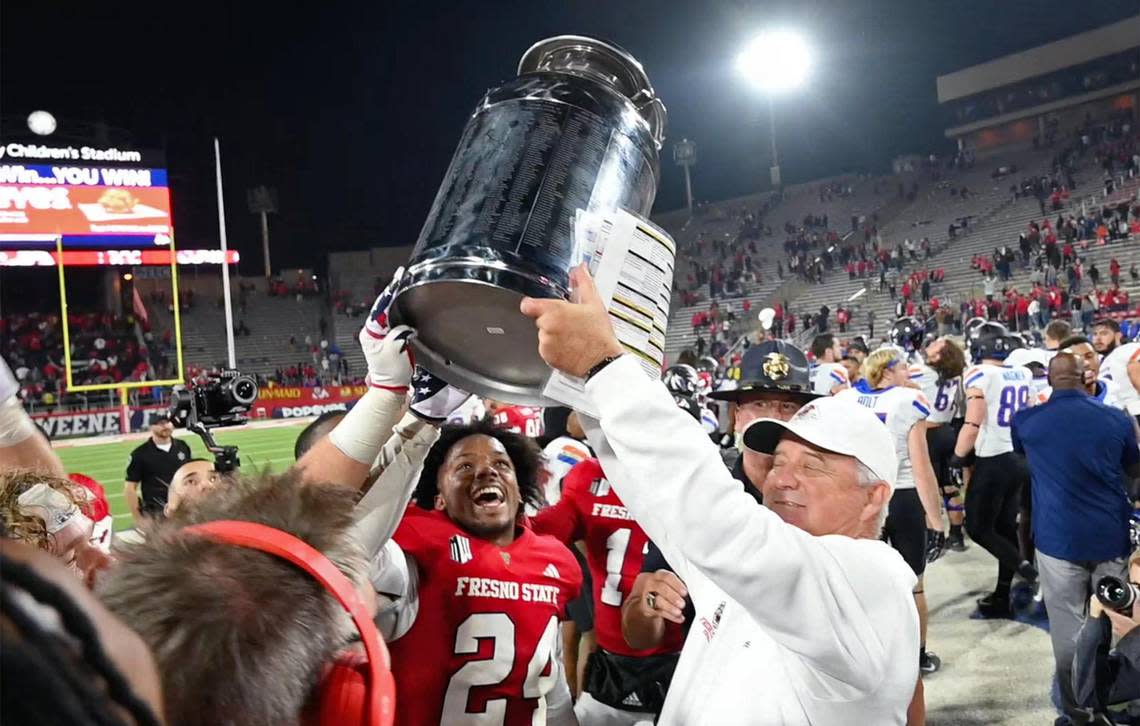After judge’s ruling, two schools can start rebuilding Pac-12. Where does Fresno State fit?

Oregon State and Washington State were granted control of the Pac-12 board of directors and a pile of the conference’s revenue on Tuesday in a tiny courtroom in Whitman County, Washington, with Judge Gary Libey upholding a preliminary injunction and confirming they are the only two voting members remaining in the league.
It was the best possible outcome for Oregon State and Washington State and while the decision will have to withstand an appeal to the Washington Supreme Court, the Beavers and Cougars can now plot a future that likely includes a rebuild of a league that was decimated by defections to the Big Ten, Big 12 and Atlantic Coast Conference.
How they utilize that power and that revenue at their disposal — somewhere between $400 million and $500 million — will be interesting to watch.
But it will have implications for Fresno State and the Mountain West, and the Bulldogs’ position in future realignment might not be as strong as it was a few months ago.
The College Football Playoff, expanding from four to 12 teams next season, reportedly is likely to be tweaked to include five conference champions and seven at-large teams rather than six and six with the demise of the Pac-12.
It also could add a rule requiring a conference to have at least eight members for its champion to be eligible for a spot in the playoff.
Oregon State and Washington State, with Pac-12 revenue that could be used to pay exit fees for schools looking to join the conference and a desire to compete at the highest level in college athletics, could make a run at the six schools with the strongest brands, biggest markets and greatest revenue potential to get to eight schools.
It would be difficult to pass up the Fresno State football program, which under coach Jeff Tedford has been built for sustained success at a level it has never attained.
Will lack of athletics revenue hurt Fresno State?
Fresno State is 8-2 with regular-season games remaining against New Mexico and San Diego State and a spot in a bowl game secured, and could win 10 or more games for the fourth time in five seasons under Tedford.
It had five seasons with 10 or more wins between 1986 and 2016.
But Fresno State is not in the top six in the Group of Five in athletics revenues or expenses and its upside is stunted by a basketball program stuck playing in the Save Mart Center, where naming rights revenue, suite leases, concessions sales and parking all go to the capital lease (debt) and the building’s operating deficit.
Even in a sensible geographic footprint that would include only the Mountain West schools, Fresno State ranks eighth behind San Diego State, UNLV, Colorado State, Boise State, Hawaii and Wyoming in operating expenses, according to Sportico. The Bulldogs at $46.5 million in operating expenses are closer to San Jose State at the bottom of the public schools in the conference ($39 million) than to San Diego State at the top of it ($67.2 million).
Oregon State and Washington State now have money and can create time by fielding a two-team conference in 2024 and 2025 — the NCAA has a two-year grace period for a conference to get back to a minimum number of teams — and then work a merger with a larger group of Mountain West schools and perhaps schools from other conferences to create the most marketable conference possible.
Expect more clarity before transfer portal opens Dec. 4
But their plans will come into focus quickly. The NCAA transfer portal window for football opens on Dec. 4, and the Beavers and Cougars will need to have a credible plan for the future to present to student-athletes in every one of their sports programs, or face the possibility of losing key players and staff.
And, the bottom line has not changed. That, of course, is money.
Oregon State and Washington State when in a healthy Pac-12 received more than 40% of their athletics revenue from media rights and distributions from the conference and the NCAA. Both are facing significant financial hits and need to try to generate as much revenue as possible through a rebuilt conference, but they at least can start.
“We are pleased with the court’s common-sense decision,” Washington State President Kirk Schulz and Athletics Director Pat Chun said in a statement. “It has always been our view that the future of the Pac-12 should be determined by the remaining members, not by those schools that are leaving the conference.
“This position is consistent with the action the Pac-12 Board of Directors took when the first two schools announced their departure from the conference more than a year ago.
“We have always been committed to protecting the best interests of the conference, our student-athletes, coaches and fans. Today’s news allows Washington State University and Oregon State University to start that process as the controlling members of the Pac-12 Conference board.”


